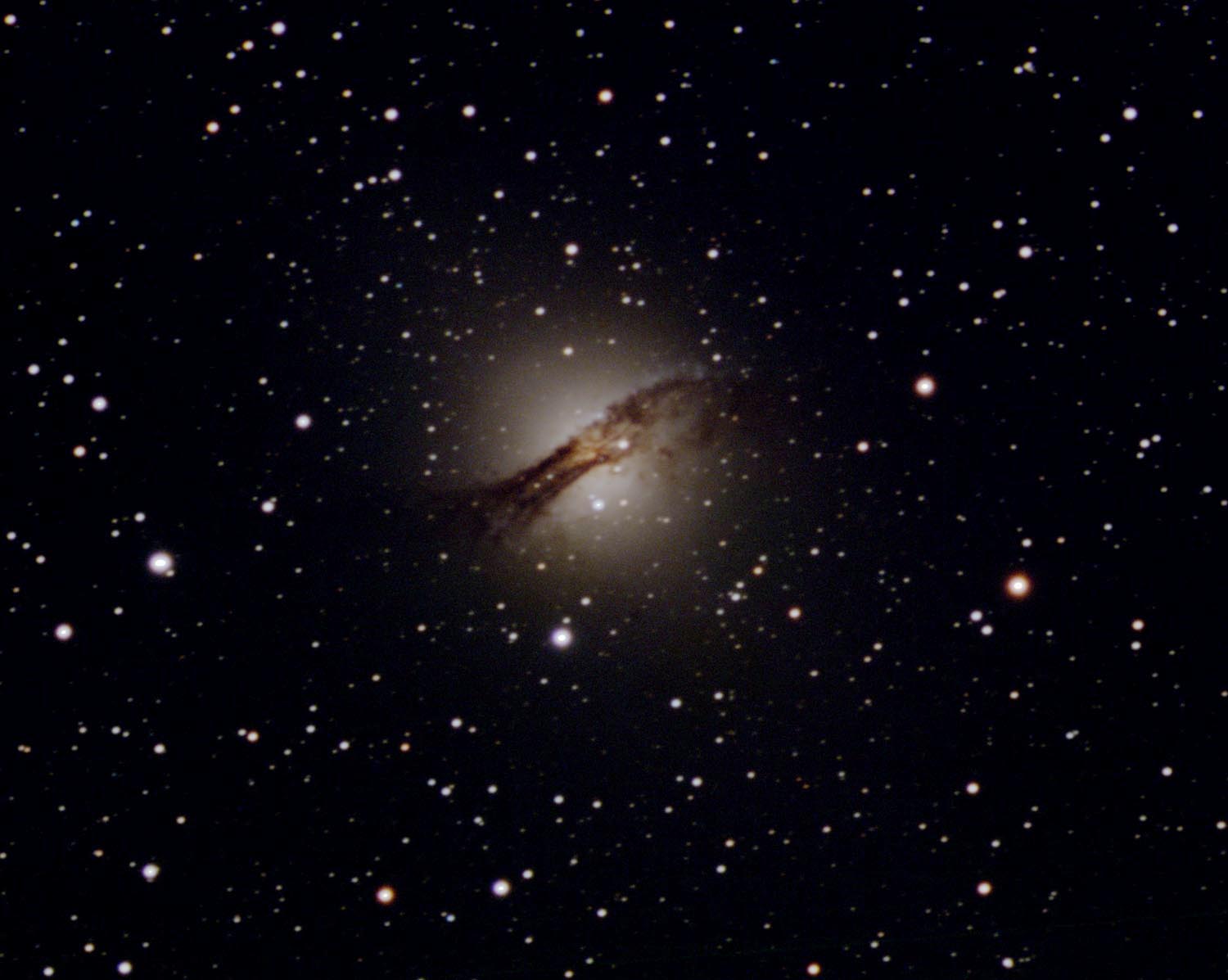
 | SOCO Blog |
12 June 2015
CENTAURUS A
So far, June has been pretty much a cloudy affair, thanks to the "Summer Monsoon" that invades the Southwestern U.S. this time of year. It brings thunderstorms to Arizona and New Mexico, and if we don't get storms here in the Texas High Plains, we get the blow-off of high clouds spawned by storms to our west. In the couple of decent nights we've had, I've concentrated on an elusive astronomical target that skirts the southern horizon in late spring. This is the "peculiar" galaxy NGC 5128, commonly known as "Centaurus A". This galaxy is located in the constellation Centaurus, and the "A" designation comes from the fact that this object is a strong radio source. Radio sources are commonly given Roman letter designations within the constellation that they are found. In this case, the source of radio emissions is thought to be a massive black hole at the center of the galaxy.
Black holes aside, the feature that makes Centaurus A such a challenging target is that, at the latitude of SOCO, it never gets very far above the southern horizon (see Figure 1). During the entire time it is up, it never has an elevation of more than 13.5 degrees. This leads to two major problems in trying to image this target. First, because the target is near the southern horizon, it stays above the horizon only a few hours each night. For long imaging exposures (like those necessary for this type of object), this means you can't get a complete set of images in one night. In this case, a complete set of images meant six 15-minute exposures in each of the red, green and blue spectral bands. Six 15-minute exposures take a little more than an hour and a half to acquire (when you include image download time). This roughly 1.5-hour period had to be centered on the culmination of the object (the time when it crosses the meridian through due south and thus when it is highest in the sky). This means that each set of six red, green and blue images had to be acquired on a separate night.

Figure 1. Star chart for the SOCO site in mid-June at around 10:00 pm CDT. The location of Centaurus A is indicated by the red cross.
Source: Your Sky Website.
Second, because the object is very close to the horizon, its light experiences a great deal of attenuation as it passes through the thickest portion of the atmosphere. During the period of image acquisition, the optical airmass (X) ranged from 4.3 to 4.5 for the red and green bands and 4.4 to 4.8 for the blue band (compare this with X = 1 for objects directly overhead). Taking into account the effects of the moisture in the atmosphere on the atmospheric extinction coefficient (k), this resulted in values of atmospheric transmissivity (A) of 0.605 to 0.629 for the red band, 0.482 to 0.508 for the green band, and 0.309 to 0.348 for the blue band. As you can see, a large part of the light, particularly in the blue band, was being attenuated by the atmosphere. This makes it critical that the raw image data be processed to correct for these effects in order to produce a correct color balance in the final color composite image.
In all, it took four nights to acquire the imagery for Centaurus A. The blue band imagery was originally acquired back on March 29, but this imagery turned out to be useless because the light from a waxing moon pretty much washed out the target. The green band imagery was acquired on May 13, while the red band imagery was acquired on May 17. So, I just had to wait for a break in the weather along with the absence of a moon to re-acquire the blue band imagery. This wait lasted until June 10 when conditions, although not the best, allowed acquisition of the needed imagery. The resulting color composite image of Centaurus A is shown below.

Centaurus A (NGC 5128)
As you can see in my image, Centaurus A is a strange-looking object. There has been a lot of debate over its actual structure. Most astronomers now feel that this object has an elliptical or lenticular form that resulted from the collision and merger of a large elliptical galaxy with a smaller spiral galaxy. Presumably, the dark band of obscurring dust is left over from the spiral galaxy. Detailed observations made under better conditions using larger telescopes show two jets of material shooting away from the galaxy center in opposite directions. These jets are oriented roughly perpendicular to the dark dust lane and extend out over a million LY. The jets are travelling at about half the speed of light and, when they collide with gases farther out from the galaxy, they create powerful emissions of X-rays and radio waves. Most of the galaxy visible in my image as a spherical glow contains older, redder stars (note that the individual stars seen on top of the galaxy are foreground Milky Way stars).
Centaurus A is relatively close, at around 10 to 16 million LY. It is fairly large, at around 60,000 LY across. This size and distance makes this object fairly bright (visual magnitude 7). In fact, it is the fifth brightest galaxy in the sky. If it weren't so low on the horizon for most observers in North America, it would be an even more spectacular object. It lies about 4 degrees north of Omega Centauri (NGC 5139), the very large and beautiful globular cluster in that constellation.
I was aware of this strange-looking object from an early age, but from an unlikely source. When I was a kid, one of my favorite TV shows was "The Outer Limits" which was on Friday nights after the late news. At the end of each episode, they showed the credits over a series of astronomical images (naturally, in black and white— no color TV yet!). One of these images was Centaurus A, although I didn't know its name until years later. Still, even at that time, I was impressed by how unusual this object looked compared to my idea of what a galaxy should look like (a spiral, like the Andromeda Galaxy). Now, after many years, I'm able to view my own image of this object.
 Return to SOCO Blog Page
Return to SOCO Blog Page
 Return to SOCO Main Page
Return to SOCO Main Page
Questions or comments? Email SOCO@cat-star.org